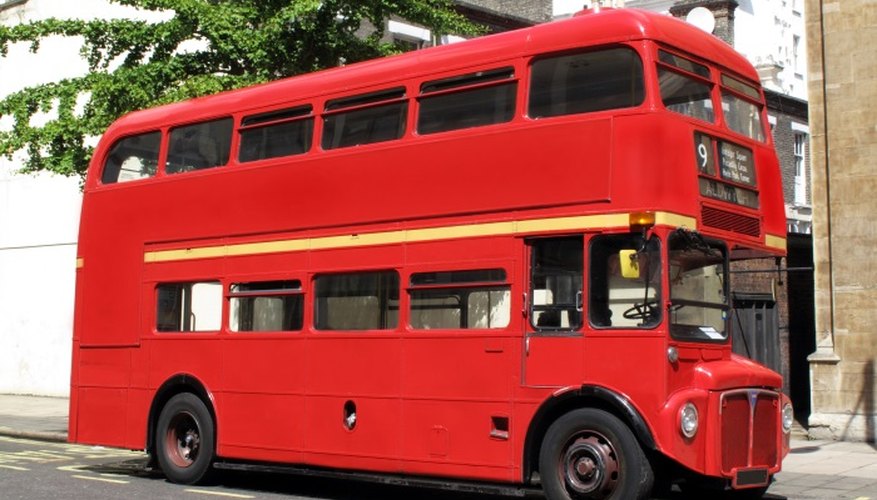Double-decker buses are passenger buses with two levels. Offering greater passenger capacity than their single-level counterparts, double-deckers offer greater economy for a variety of uses. While they are often associated with London, these buses are used in cities all over the world, carrying passengers in both private and public enterprise.
Description
Double-decker buses are designed for heavy passenger loads, carrying up to 100 seated passengers. This provides an economical advantage: more people can be carried for a similar operating cost to a single-level bus. While double-decker buses were operated with a two-member crew in the past, most modern buses are staffed by a single bus operator. The first level of the bus typically contains the bus operator’s cab and seating. A stairwell connects to the second level, which typically only contains seating. While the second floor of the bus is not accessible to the disabled, modern double-decker buses provide accessible seating on the first floor of the vehicle.
- Double-decker buses are designed for heavy passenger loads, carrying up to 100 seated passengers.
- While double-decker buses were operated with a two-member crew in the past, most modern buses are staffed by a single bus operator.
History
Double-decker buses have been in operation since the turn of the 1900s. However, the first motorised double-decker buses began operating after World War I. Primarily used in England and France, these buses were made in a variety of different styles. The double-decker bus became an icon with the Routemaster models used in London between the 1950s and late 2000s; their famed red livery became a common reference to London in popular culture. Double-decker buses are still built by several manufacturers, including Van Hool and Alexander Dennis.
- Double-decker buses have been in operation since the turn of the 1900s.
- Double-decker buses are still built by several manufacturers, including Van Hool and Alexander Dennis.
Dimensions
Double-decker buses come in numerous sizes depending on model and manufacturer. Routemaster buses were 4.37 metres (14.5 feet) tall, 2.44 metres (8 feet) wide and 9.14 metres (30 feet) long. Though specifications vary from model to model, modern double-decker buses have similar dimensions, usually about 4.5 metres (15 feet tall), 2.44 metres (8 feet) wide and 12.2 metres (40 feet) long. The length and width are comparable to other transit buses, making them an ideal option for high-ridership transit routes.
- Double-decker buses come in numerous sizes depending on model and manufacturer.
- Though specifications vary from model to model, modern double-decker buses have similar dimensions, usually about 4.5 metres (15 feet tall), 2.44 metres (8 feet) wide and 12.2 metres (40 feet) long.
Use in private enterprise
Double-decker buses are commonly seen in use for tourist transportation, and double-decker sightseeing tours are available in many cities. While some tour companies operate modern models, many of these buses are former public transit buses that were acquired in aftermarket sales, and famous models are not uncommon among tourist bus fleets. Some double-deckers find service with private long-distance coach operators such as MegaBus, which offers city-to-city travel in America and the UK.
Around the world
Double-decker buses are used in public transportation worldwide. While long used in Europe, their use expanded to India and Asia as early as the 1930s. Recently, American public transportation industries began to experiment with the use of double-decker buses, including trials in New York City and San Francisco. In 2005, the Las Vegas Regional Transportation Commission (RTC) introduced a bus route using exclusively double-decker buses. Nicknamed “The Deuce,” this service transports riders along the famous Las Vegas Strip. Community Transit, serving parts of Greater Seattle, will begin operating double-decker buses in 2010.
- Double-decker buses are used in public transportation worldwide.
- In 2005, the Las Vegas Regional Transportation Commission (RTC) introduced a bus route using exclusively double-decker buses.
